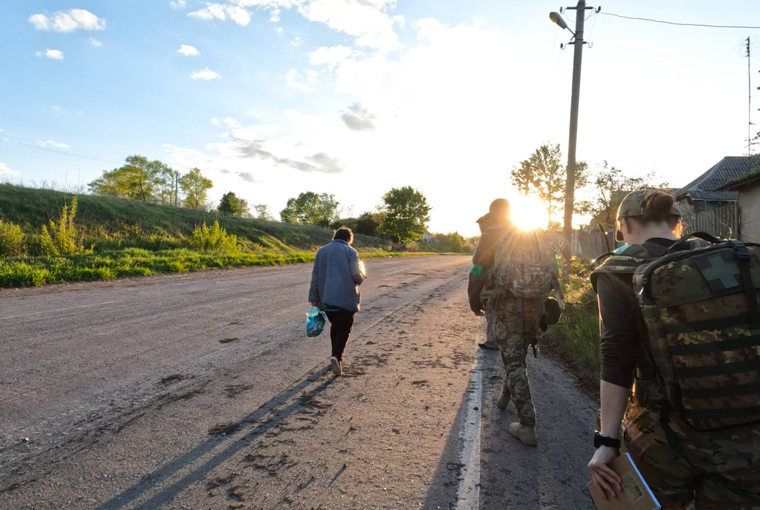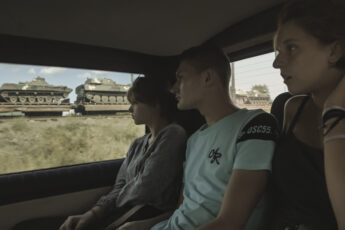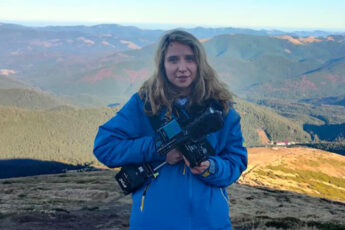The Course of Things to Come
Vitaly Mansky and Yevhen Titarenko’s Eastern Front (Shidniy front, 2023)
Vol. 135 (May 2023) by Tajana Kosor
This is the central axis of the capital of Ukraine.” As the opening line of Vitaly Mansky’s voice-over narration fills the soundscape, we observe his fellow co-director Yevhen Titarenko poking around at a Russian tank in the middle of Kyiv’s city center with his friend Kosa. Never visible, with his voiceover serving almost as a prop, Mansky chronicles their predicament: “Our film begins in the early morning of February 24th, 2022.” But the joke’s on us: “Then, the whole world finally noticed this war.”
The documentary form of the film, what it depicts and how it arranges the narrative through editing, provide legroom for the first, essential layer of the film – the war and its consequential as well as contemporary results. The second layer is comprised by the fact that we are watching the film while the war actions documented on screen continue to be carried out. And the third layer is the unpacking of the privilege that allows us to be both surprised by and indifferent towards what we’re being shown. It is December first 2022, and I’m on the metro to work. One of the headers in the newspaper I’m reading states: “After nine months of war, nothing is so new as to be shocking […].” Our inherently privileged position – marked by our implicit shock – almost invites metacriticism, but the extensive reach of the mainstream media’s stunted arms can only extend thus far. I screenshot and repost the headers to see what happens: the reactions on my social media are as sleepy and lukewarm as the faces of the people on public transport at 8 am.
Fast-forward a couple of months: the Berlinale and the film’s premiere are now behind us. This time, the morning after the premiere on the metro, as I read the news on my phone, the header reads: “In this video, see how Ukrainian military psychologists are training soldiers to confront trauma.” The news feels more detached, as does the world, and the film suddenly belongs to another reality, another realm from the one I find myself in on the metro. Here, it’s perfectly normal to forget as soon as the train is late; the carriage is crowded and smelly; people are distressed and violent. Paul Ricoeur raised the question of whether history ‘over-remembers’ some events at the cost of others – we could conversely pose the question whether the present over-forgets certain events.
The Formality of Form
As far as what the film claims to aspire to achieve, its form serves its purpose well. But how does one report on the war, even on screen, when the war beyond appearances seems less real than the film in question? Until the film itself renders it real?
In abstraction from the film’s proposition, the form and structure leave much to be desired. Generally speaking, in Eastern Front any sort of cinematic methodology is stripped down to the bare minimum or is entirely lacking from the beginning. And whilst one could argue that it is this very bare-boned approach which is the cinematic methodology of the film, its subject matter makes us wonder if we’re even entitled to demand anything from cinema – from films in general, and from this film in particular. It feels almost blasphemous to write that a war documentary is a semi-successful film, yet these are the only parameters that cinema itself leaves us with.
It seems that the intention was to keep that which is depicted as real as possible – knowing that we are always already modifying a portrayal of reality from the moment we’ve picked up the camera –, but in showcasing a landscape so stretched out already, disfigured by the media and our own projections, perhaps the film serves as a silent documentation of reality’s crude circumstances all the more. (‘Circumstance’ being a tricky word in this context as its etymology implicitly points to coincidence.). Thus, the “formless” shape of the film and all the back-and-forth and running in circles do not capture reality so much as they are aligned with this particular reality. And that’s something to think about.
We are in the basement now (“at least a cup of coffee before I go out”); we are in the ER van with a man severely wounded – his neck hit by shrapnel – and a volunteer tries desperately to keep him awake by singing to him. We see volunteers and civilians interact, we see handheld devices, the camera following from behind. The scenes, raw and uncensored, almost seem like a loosely structured wake-up call.
“Western Ukraine, we are alive, everything is fine,” the members of Hospitallers exclaim, a volunteer medical battalion that works as a type of on-call unit for wounded soldiers. Theirs is the focal point of the story, somewhat reminiscent of the documentary Midnight Family (dir. Luke Lorentzen, 2019). In what is perhaps one of the most human parts of the film from the frontiers, they wander around in fields and trenches abandoned by a Russian unit: a book called Heaven Can Wait lies in the semi-subterrestrial shelter, there is an “officer chocolate” on the ground, they find a pan – little signs of life left behind. In the film, the act of recounting and retelling is depicted as if memories allowed us to glance into our own past – or is it future?
We’re back on the streets, then at the frontline – the film becomes quite circular after some time. And while this reiterative approach might, at its core, in fact be symptomatic, so are many other motives the film starts building upon but ultimately abandons or leaves behind, thus weakening its own structure.
The Central Axis
The scenery suddenly changes – men sit by the lake, recounting memories, anecdotes, and childhood stories. Immediately it seems as if we were given the key (for what?). It’s not entirely clear what we’re looking at – is it a parallel action course, a string of events tucked away somewhere, a life put on pause for the time being? Or is it another lifespan, having taken place a long time ago, only to be reopened for a visit now, in times of crisis and emergency? And how do these two parallel lifelines coexist, even resemble one another?
A man talks about his recurring need to go to war, the gravitational pull he feels whenever he’s away from the frontline. The landscape around him seems peaceful, stagnant almost, “in short, legs are lying around.” Reality changes its course: the issue of sperm donation for gene preservation purposes suddenly becomes a regular topic at the dinner table. Everything that is taking place begins to feel like it’s part of a carefully constructed fable – a group of people sitting in a field, eating, lamenting the war and radiation as if talking about the next peach harvest. We catch a glimpse of a tiny life, of its place in time. It is the universality of these shots that single-handedly makes them the film’s central axis.
Suddenly we see stray animals wandering aimlessly in the streets. We turn to the image of cows stuck in the deep mud – they too could be part of a painting. “They will all die here,” the soldiers deplore after an unsuccessful effort to “scare” them out of the bog – “the swamp swallowed them.” And while this shot of cows faced with their own imminent death, up against the earth, might be the most poignant and cinematic image of the entire film, another animal-related scene, much more traumatic, immediately comes to mind. Here a dog is shot by accident, after which he endures an excruciatingly long death – a scene whose inclusion could easily be deemed completely unnecessary. Yet the image simultaneously stands on its own as an independent memorabile of terror and unpacks the levels of fear rooted deeply within the irrational, the subterranean of humankind.
More landscape shots capture the distant horizon. The day shuts down. Men enter an abandoned house: “A whole life has been left behind here.” They make tortillas in the kitchen while grenades start falling outside – the sky looms in the distance, hopeful and menacing at the same time.
Imagine the Ending of this Film
“Let’s imagine the ending of this film,” one of the protagonists says as they are seen driving off in a van. How is it going to end? In the first version they recapture Kherson – and if this were a fiction film, it ends with Ukraine’s victory. What if it was a science fiction film? The Red Square is already on fire. The question that remains is what do you do once the film is over, but the nightmarish landscape you got to know by leaning into the screen becomes more real by the end of the film? If the showcase is the event, how do we go about our lives having seen it once? And if we are too disturbed to watch, how come we aren’t too disturbed to endure? Who was it that spoke of the act of waiting as an act of forgetting? ‘Active forgetting’, the Nietzschean kind – forgetting by keeping in mind. And for a brief second, all is forgotten. We almost can’t remember whether the contrasting pastoral scenes of peace were ever there and tangible, or if they were simply given to us as a gesture of kindness: a short breath of clean, fresh air; our eyes closed for a couple of moments, artificial lights removed, and the sunlight filled with warmth resting upon our shut eyelids. Maybe they are scenes from another life, already lost and mourned after, and on display only now as the ultimate, yet humble goal – to go back to what we once thought we’d owned. But history remembers. And in a destiny already predicted and denied, the only relevant placement is that of a reminder of what is going to be regained. The film stays with us after having watched it because it’s truthful, which is the most a film can hope to be.




Leave a Comment